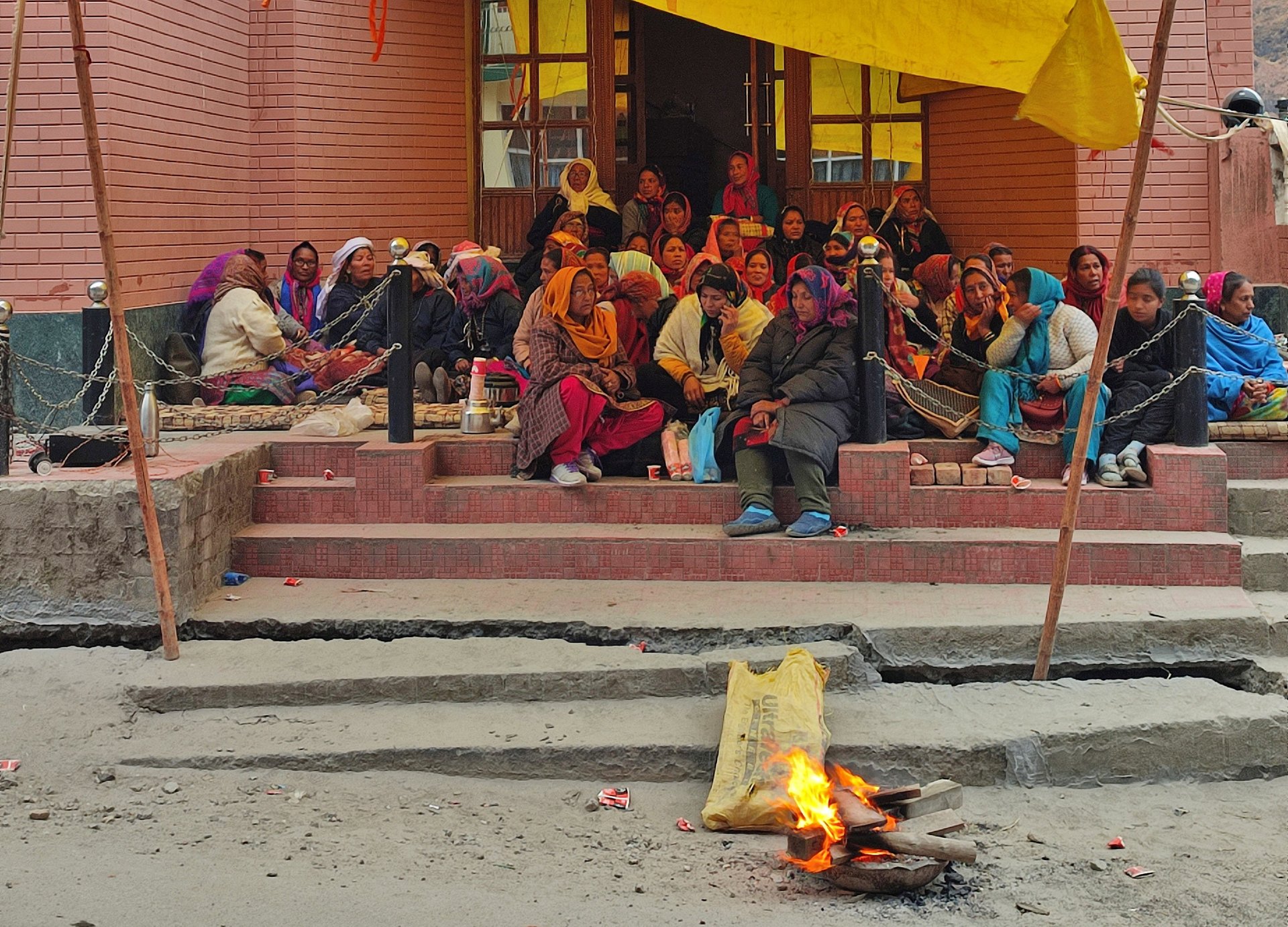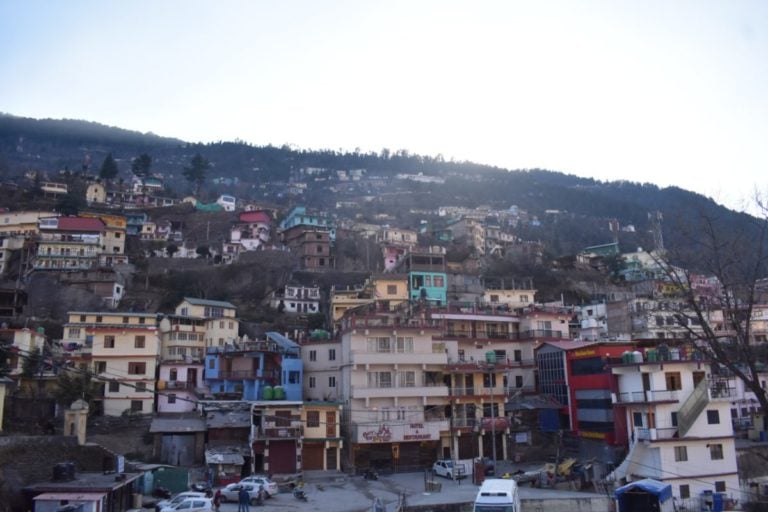Why an Indian Himalayan town is sinking
The buildings of Joshimath first developed cracks in the 1960s. Now hundreds of people there live in fear

Rishi Devi, 37, has presently taken shelter in a government school in Joshimath along with her family. As the temperature dips to minus 3.5 degrees celsius on the cold winter nights, she survives with a few woollen clothes that she has. She is worried about the health of her six-month-old baby.
Like Rishi Devi, many families in the sinking town of Joshimath, a city and municipal board in the Chamoli district of Uttarakhand, are forced to live in temporary shelters these days.
As of Jan. 9, 678 homes in nine wards in the state had developed cracks and became unfit for residing, as per the government figures. So far, the local authority has moved 81 people to temporary accommodations. The local authority has made alternate arrangements for 4,000 people in Joshimath and the nearby Pipalkoti.
“Our house is completely damaged. The administration has shifted us to a government school, but it is not easy to live here in this chilling cold along with my six-month-old baby,” says Rishi Devi.
Like her, Kishore Kumar Valmiki, 28, is anxious about his future. There are six members in his family—his parents, his wife, and two children. At present, they do not have a roof over their head. Elaborating on the condition of his house, he says, “I work as a sweeper in the municipal corporation. My house first developed cracks around 14 months ago. We rented another house in Joshimath, but that too has developed cracks now.”
Similarly, Veena Devi, who lives in ward number one in Joshimath, had received a house under the government’s welfare scheme, but it has now become dangerous. “We are Dalits. We received the accommodation under Pradhan Mantri Awas Yojana. We feel anxious to live in that house. We are constantly in fear that something untoward may happen.”

Why is Joshimath sinking?
Situated 1,875 metres above sea level, Joshimath is an important gateway to several Himalayan expeditions, trekking trails, and pilgrim centres. It is also an important halting place and resting point for the pilgrims who visit Badrinath and Hemkund Sahib in the summers and tourists who visit Auli in the winter. The number of tourists kept increasing year after year, which provided the locals with many employment opportunities, but the rapid development also led to multiple problems for Joshimath.
According to experts, the fragile mountainous region could not bear the brunt of rampant development and the construction of roads and luxurious hotels.
SP Sati, an associate professor who teaches environmental science at the College of Forestry in Ranichauri, spoke to Mongabay-India and elaborated on the root cause of the present crisis in Joshimath. Professor Sati, who is also an expert on ground studies, says, “Joshimath is situated on debris left by ancient landslides. If we go back in time, it was the capital of kings belonging to the Katyuri lineage. The kings had to relocate after some natural calamity hit the town.”
The buildings in Joshimath first developed cracks in the 1960s. That was the first proof of cracks forming in the mountains of Joshimath, and it was felt that it could be dangerous for the residents. The situation deteriorated quickly to an extent that the then government of Uttar Pradesh constituted the Mishra Committee under the chairmanship of then commissioner, Garhwal Mandal, to find out the reasons behind the sinking of the town. The committee submitted its report on May 7, 1976.
One of the Committee’s recommendations suggested an immediate need to stop the blasting of boulders. The other recommendations included developing a pucca drainage system in the town to stop seepage of rainwater, avoiding digging at slopes and collecting construction material in the five-kilometre vicinity, and a ban on chopping trees to prevent landslides.
However, despite these recommendations, the construction of roads, dams, tunnels, and multistorey buildings continued unabated. The situation is so bad now that the very existence of Joshimath is in danger.
SP Sati adds, “It is now impossible to undo the damage. At the rate at which buildings are developing cracks, it seems as if most of the terrain of Joshimath will cease to exist. The administration’s priority should be to help people evacuate and shift them to temporary accommodations. However, if we want to ensure that no other city in any other state should meet the same fate as Joshimath, we must make concrete policies.”
Safe evacuation is a priority
Social workers, who have been highlighting the plight of Joshimath for years now, are demanding that the administration help people evacuate safely.
Anoop Nautiyal, the founder of the Social Development of Communities Foundation, says, “The situation in Joshimath has gone out of hand. To avoid massive disasters, the government should help the residents reach safe places immediately.”
The administration is helping residents whose homes are completely damaged to shift into municipal buildings, primary schools, gurudwaras, and lodges. Raising questions over this move by the administration, Nautiyal asks, “As these places are in Joshimath, are these buildings safe?
An environmentalist Himanshu Thakkar, also a coordinator at the South Asia Network on Dams, Rivers, and People (SANDRP), shares that the geography and hydrology of Joshimath are very fragile. “Over the past few years, many incidents occurring in and around Joshimath point towards something disastrous happening in Joshimath,” he indicates.
Thakkar talks about past disasters like the 1970 landslide, the sudden gushing of a water stream while building a tunnel for the Tapovan-Vishnugadh project, and flash floods at Raini village in 2021. He adds, “The administration ignored people’s complaints regarding cracks developing in their buildings for months. In December 2022, the National Thermal Power Corporation Limited (NTPC) used explosives to drill a tunnel at one of its project sites. After this, there have been reports of large quantities of water gushing out at some spots.”
“Joshimath falls in the seismic zone. Hence, commissioning a project like the Tapovan-Vishnugadh one in itself is a disaster. In the upper Himalayan region too, many such projects may eventually prove fatal,” Thakkar says.
Protesting residents blame the government for apathy
Atul Sati, an activist, and a member of the Joshimath Bachao Sangharsh Samiti informs that during the flash flood at the Raini village in February 2021, thousands of tonnes of debris got drained into the river. Raini and Joshimath fall in the same geographical area, so that disaster must have an impact on Joshimath, he claims.
Atul feels that the cracks people are witnessing now could result from that incident. He also feels that the cracks developing in buildings could go up rapidly because of the NTPC’s Tapovan-Vishnugadh hydropower project. Many tunnels are being drilled as part of this project.
He says people have been alerting the authorities about the cracks for a long time. However, the administration did not pay any attention.
He adds, “After witnessing the administrative apathy, the residents of Joshimath requested a team of geologists to conduct an independent survey. The survey shows that Joshimath has been sinking continuously, which may lead to a disaster soon. After this, we intensified our movement, and on Jan. 5 this year, we protested on the highway connecting Badrinath.”
Activists are also questioning how the administration is helping people evacuate and transporting them to safe locations.
The district disaster management authority has been issuing daily bulletins on the situation in Joshimath. As per the latest bulletin issued on Jan. 9, arrangements have been made to provide temporary accommodation to 1,191 people within Joshimath and 2,205 people in the nearby Pipalkoti.
Questioning the government’s effort, Anoop Nautiyal says, “On Jan. 5, the administration helped 385 people rehabilitate and after two days, the number went up to 1,271. If the government has to rehabilitate 15-20,000 people, why are they moving at a snail’s pace?”
He adds, “This is an emergency, and the government must act fast to win people’s trust as they are panicking.”
The administration steps in
On Jan. 7, the chief minister of Uttarakhand, Pushkar Singh Dhami visited Joshimath. He met with the affected families and requested the administration to take all the necessary steps, including airlifting people if necessary.
Himanshu Khurana, the district magistrate of the Chamoli district, took to his Twitter handle to inform that the families rendered homeless due to the natural calamity would be given Rs 4,000 per month ($50) from the chief minister’s relief fund for six months. Also, 46 disaster-affected families in Joshimath would be provided with Rs 5,000 per family to buy essential household items, and a sum of Rs 2.30 lakh has been reserved for the same. The authorities are also providing dry ration kits and cooked food packets to the needy.
This article was originally published in Mongabay India.